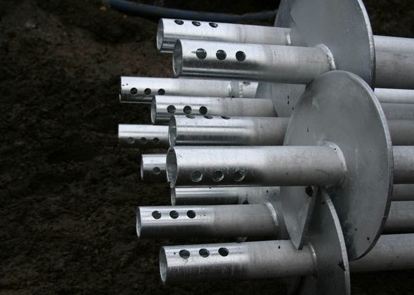Also known as screwpiles or screw piles, helical piles are essentially giant steel screws used in ground anchoring for securing deep foundations.
During installation, helical piles are wound into the ground, much in the same way that a traditional screw would be driven into a piece of wood, except in the case of a helical pile a large piece of equipment with a rotary attachment is used to screw it in, instead of a screwdriver or drill. This can be achieved with a variety of types of machinery, including skid-steer loaders and excavators of various sizes.
It’s absolutely vital that helical piles are installed properly. Otherwise, they may not be able to accurately perform the tasks for which they are intended. The outcome of that could be that the building is not as safe as it should be. Incorrect installation of the piles can result, then, in the piles not performing properly.
Helical piles are not a new product. They have been used in construction since the 1800s, at which time they were used in the construction of lighthouses and piers. As the 19th century progressed, more and more lighthouses were constructed using screw piles made of iron (either cast or wrought) and although they were strong, they had limited weight-bearing capacities. These days, however, modern screw piles are designed to withstand very heavy weight loads – upwards of about 200 metric tons. Today, screw piles are made of composite, which are designed to have several advantages over steel.
In modern applications, helical piles are still used frequently. Their use has extended far beyond lighthouses, however! Nowadays, they are used in the rail industry, in the construction of roads, in the telecommunications field, and in other industries. They are very useful anywhere quick installation is necessary or where construction is required close to other existing structures. They also are beneficial because they are relatively low cost to use and they have minimal negative environmental impact. This is because screwing the piles into the ground involves less displacement of the soil. That means that soil does not need to be transported from the dig site. That means that the carbon footprint of the project is lower, as is the cost.
The primary benefits of helical piles, then, are that they result in shorter project times, they are easy to install and access, they have a minimal environmental impact, they can be easily removed when necessary, and they are cost effective to use. A final benefit is that using screw piles pose little safety risk to those installing them.
